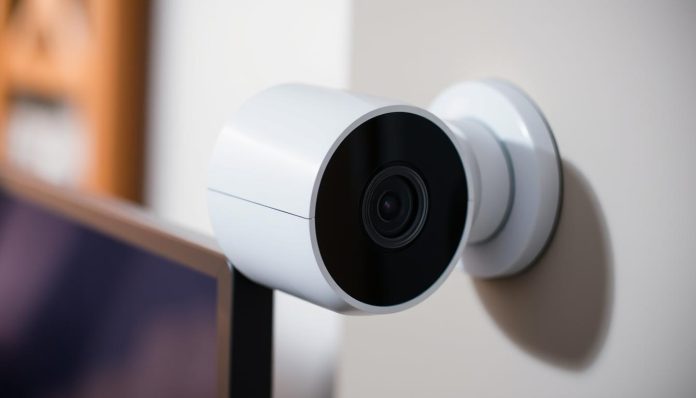You need clear facts to pick the right nest cam for your home. This intro gives a concise look at how one camera model performs when set up inside or outside. Expect simple comparisons that focus on security, placement, and daily use.
The camera offers 1080p video, a 130° view, night vision, two-way audio, and a magnetic base. You can run it on battery or wire it with an optional weatherproof cable. That choice affects uptime and the chance for continuous recording.
On-device detection spots people, animals, and vehicles with a free three-hour event window. With a subscription you unlock Familiar Faces, longer event history, and 24/7 recording when wired. Video is encrypted in transit and at rest, and local controls let you pause recording when you are home.
By the end you’ll know how placement, power, and settings change protection, footage retention, and app experience. That makes it easier to decide which setup fits your privacy-first and security-focused needs.
At-a-Glance Verdict: Which Nest Cam fits your home security needs
Pick the model that matches how you live: the battery model for flexible installs, the wired option for steady power, or the floodlight version for bright deterrence.
The lineup prices are straightforward: the battery camera runs about $179.99, the wired camera is $99.99, and the floodlight model is $279.99. All cameras give a free three-hour event history and up to one hour of on-device video during a Wi-Fi outage.
For single-unit flexibility, choose the battery camera. It works inside or outside, offers easy installs, and supports battery or wired power with strong detection and simple app control.
If you want the best price-to-performance for a living room or hallway, the $99.99 wired camera is the top rating pick for always-on streaming and low maintenance.
- Floodlight option adds bright illumination for night deterrence while keeping the same app experience and AI detections.
- For longer storage, add Nest Aware; for 24/7 history on wired units, upgrade to Aware Plus.
- Tune motion zones and focus on people detection to cut false alerts and save storage.
How the latest Nest Cam lineup differs indoors vs outdoors
Placement and power change performance more than core specs. The same nest cam hardware offers identical features like 1080p video, IR night view, two-way audio, and AI event detection. That shared base makes setup choices the real differentiator.
For covered porches, the battery model’s IP54 rating usually suffices. Add the $35 weatherproof power cable when you want a wired outdoor setup and potential 24/7 history with Aware Plus.
Indoors, you’ll aim for stable Wi‑Fi, corners that reduce glare, and tight activity zones for fewer alerts. Outdoors, focus on weather shielding, higher mounts to deter theft, and tighter motion zones to ignore passing cars.
- Battery mode: flexible placement but variable battery life based on traffic.
- Wired mode: steady power, better uptime, and expanded storage when subscribed.
- App experience: identical live view, timelines, and sharing across setups.
In practice, the main differences are power, placement, and exposure — not the device’s core capabilities. Configure settings to match the environment and you get the best blend of convenience and security.
Video quality and field of view: clarity, HDR, and real-world coverage
You’ll notice the difference between models when HDR, field of view, and app zoom change what you can actually see.
The nest cam streams at 1080p, giving a crisp baseline for everyday monitoring. The battery model adds HDR to tame bright windows and sunny yards, which improves overall video quality.
The diagonal field view runs about 130° for the battery and outdoor types, and roughly 135° on the wired indoor camera. That range covers most rooms and porches without heavy edge distortion.
You can pinch-zoom up to 8x in the app and lock a persistent zoom on a doorway or driveway for repeat checks. Use activity zones with that lock to cut false alerts and focus on the exact angle you care about.
- Night vision uses IR LEDs to keep faces legible at typical indoor distances.
- Two-way audio works with live view so you can speak without digging through the timeline.
- Outdoors, tilt down from eaves and avoid direct headlights to reduce glare.
Privacy, encryption, and AI on-device vs in the cloud
On-device intelligence handles key detections to limit cloud dependence. Your nest cam runs person, animal, and vehicle detection on its built‑in ML chip. That keeps most analysis local and speeds up alerts while reducing raw footage sent to the cloud.
Video is encrypted in transit and at rest, protecting uploads and long‑term storage on company servers. Use the app to review storage settings and who can access clips.
An LED shows when the unit is processing or actively streaming, so you know when the device is live. You can also set Home/Away routines to pause indoor recording when you’re home.
- On‑device detection reduces false alarms and gives faster, more relevant notices.
- Familiar Faces with nest aware pairs local recognition with your labeled library for easy filtering of known visitors.
- Set activity zones to exclude private areas and disable audio in sensitive rooms to limit oversharing.
Keep firmware updated via the app and use strong account passwords with 2FA. Combining local AI, encryption, and good account hygiene gives you a balanced privacy and security posture for your home setup.
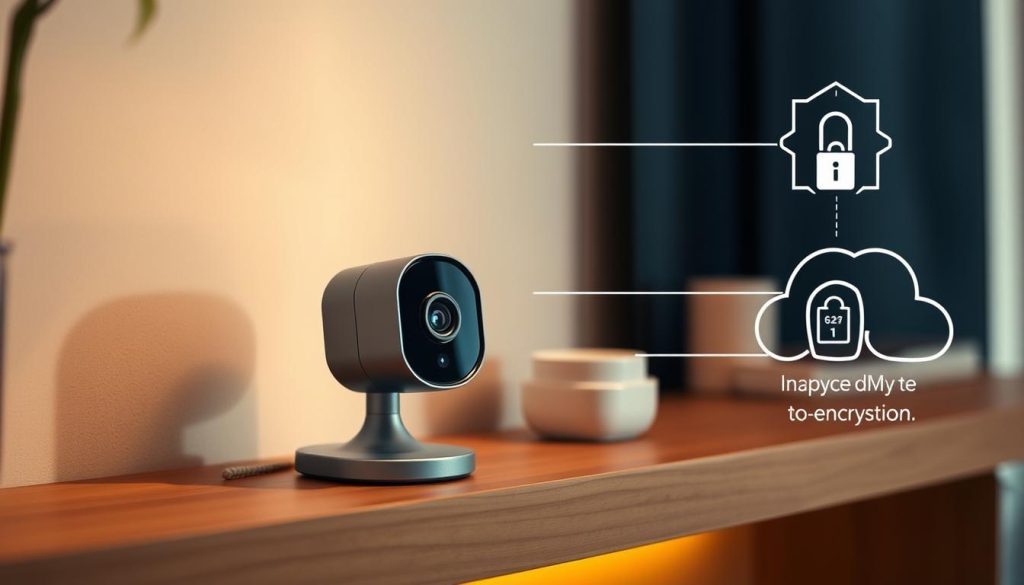
Storage options, video history, and Nest Aware subscription costs
Your storage choice shapes access to past events and monthly cost. All nest cam units include three hours of free event clips. That gives quick checks for recent motion without a plan.
Upgrade to nest aware for $8 per month for 30 days of event history. It also adds Familiar Faces and priority sound alerts. The nest aware subscription is billed month-to-month, with annual savings available.
Choose Aware Plus at $12 per month for 60 days of events and up to ten days of 24/7 history on a wired cam. One subscription covers every camera on your account. Devices also buffer up to one hour during Wi‑Fi outages so footage uploads later.
- Use app filters and labeled events to skip to important clips.
- Night motion can create many short clips; 24/7 history fills missing context.
- Tune detection to avoid cluttering your event storage.
| Plan | Monthly | Event days | 24/7 history |
|---|---|---|---|
| Free | $0 | 3 hours | None |
| Nest Aware | $8 | 30 days | No |
| Aware Plus | $12 | 60 days | Up to 10 days (wired) |
Power, battery life, and uptime: wired vs battery trade-offs
Power choices change how often you recharge and how much video you can rely on.
Battery mode gives flexible placement and long runtime if traffic is light. Expect busy locations to run about 1.5 months (20–25 events/day). Typical spots average roughly 3 months (9–12 events/day). Quiet areas can last up to 7 months (2–4 events/day).
The magnetic base makes swapping for a charge easy. Pop the camera off, charge it, then snap it back without re‑aiming hardware.
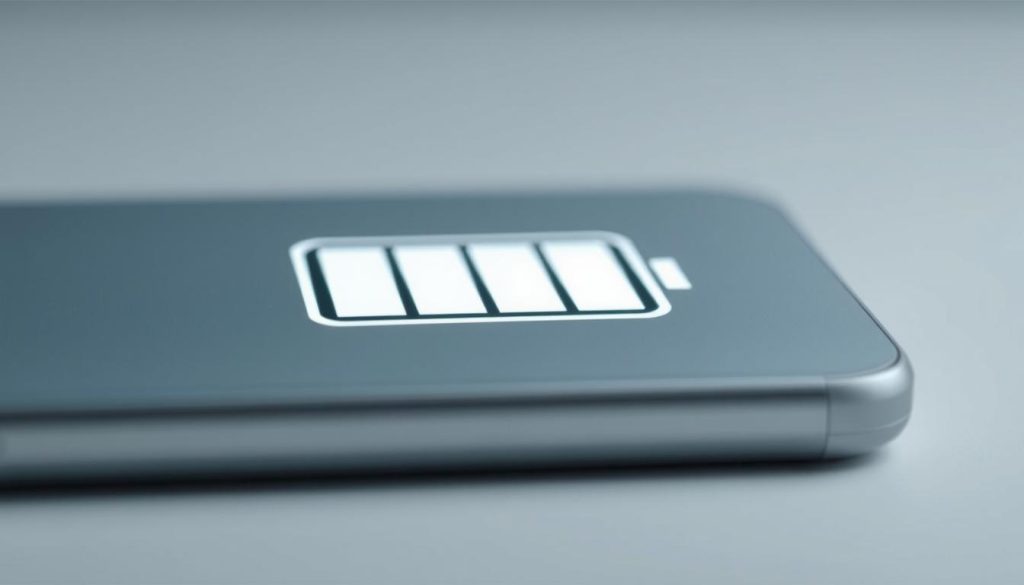
For set‑and‑forget uptime, plug the camera in with the $35 weatherproof power cable. Wired installs enable Aware Plus 24/7 history and remove charging cycles. Wired power also helps in cold climates, where lithium runtime drops.
- Use schedules and activity zones to cut needless triggers and extend battery life.
- One hour of on‑device buffering protects key video during outages.
- For gates or busy sidewalks, wired power prevents missed events and supports continuous timelines.
Weather resistance and durability: IP ratings explained
IP ratings tell you how much dust and water a camera can tolerate before performance degrades.
The battery model carries an IP54 rating, which means limited dust protection and splash resistance. That makes it fine under eaves or on covered porches but not for fully exposed roofs or storm‑facing mounts.
Older IP65 units were tougher against heavy spray. If you need stronger defense, choose the floodlight model or fit the mount behind architectural shielding.
- Place battery units under porch ceilings to avoid wind‑driven rain and direct spray.
- Cable ingress often fails first — use the weatherproof power cable and good strain relief outdoors.
- Inspect gaskets and mounts after extreme heat, freeze cycles, or hail to prevent leaks.
- Clean lens and housing in dusty, windy locations to keep video sharp and detections reliable.
- Indoors you can focus on angle and privacy controls rather than rugged mounting.
| Model | IP rating | Best placement |
|---|---|---|
| Battery unit | IP54 | Under eaves, covered porch |
| Older outdoor | IP65 | Fully exposed locations |
| Floodlight | Weather resistant | Driveways, entryways |
Document serials and exact placements. If a cam is stolen, a prompt police report speeds replacement and any storage claims.
Smart home integrations and app experience
A unified app experience makes checking multiple cameras feel fast and natural.
You can view live feeds, timelines, and alerts in the Google Home app and switch between units around your home in seconds.
Voice commands cast video to Nest Hub displays, Chromecast TVs, Echo Show, and Fire TV so you can glance at an entryway hands‑free.
Tie Philips Hue lights to live view to dim screens and cut glare or to flip on exterior lights when motion triggers an event.
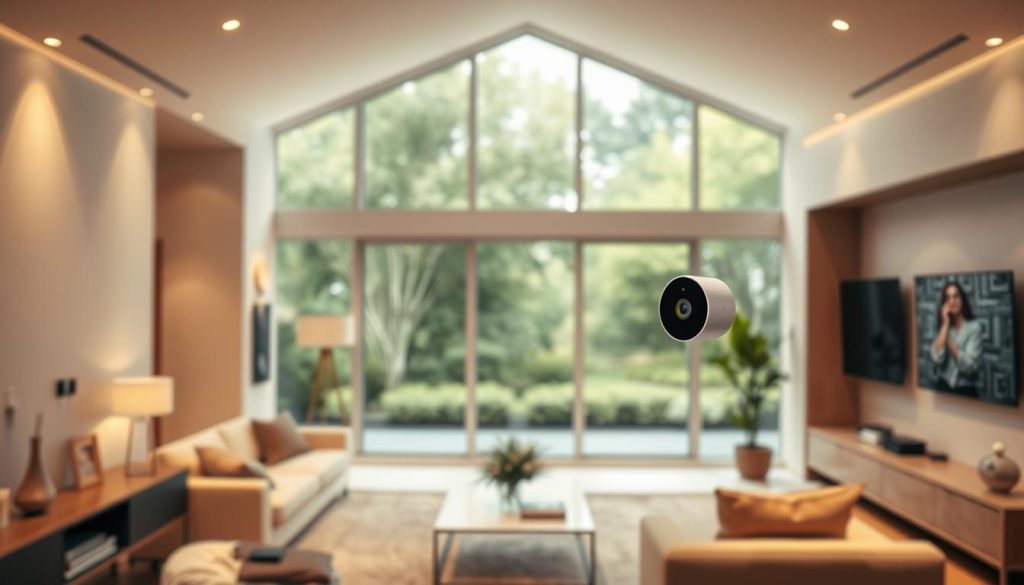
The app earns strong ratings—about 4.7 on iOS and 4.2 on Android—which reflects easier navigation, faster notifications, and cleaner device management.
- Quick setup uses QR pairing and in‑app mounting tips to get you from box to stream fast.
- One subscription covers unlimited cameras, letting you scale from a single living room battery unit to whole‑home coverage without extra plans.
- Create Household routines to arm indoor cams when you leave and pause them when you return to preserve family privacy.
- Group cameras by area—front yard, backyard, interior—for one‑tap monitoring and smoother workflows.
- Fine‑tune alerts per device to filter by people and zones so only meaningful video reaches you.
- Battery indicators and status tiles warn when a unit needs charging while wired cams stay online continuously.
Audio, night vision, and detection performance
Clear audio, strong night vision, and smarter detection combine to shape how useful the camera is after dark.
All current models include two-way audio and infrared night vision. The newer units have improved audio clarity, so short talks through the device sound more natural. Six high‑power IR LEDs produce sharp black-and-white night footage at typical porch and room distances.
AI handles people, animal, and vehicle detection on device to cut false alarms. With a subscription you gain Familiar Faces and sound alerts for faster recognition of known visitors.
- Two-way audio lets you greet delivery drivers or warn off intruders without opening the door.
- Infrared night vision keeps faces legible in low light for usable evidence.
- Refine activity zones to focus on walkways and doors to reduce unwanted pings.
- Combine person alerts with lighting automations for added deterrence at night.
| Feature | Included | Optional with Aware |
|---|---|---|
| Two‑way audio | Yes | — |
| Night vision | 6 IR LEDs | — |
| On‑device detection | People/animals/vehicles | Familiar faces recognition |
| Exportable footage | Yes | Extended 24/7 history (wired) |
Use the app to scrub events, export clips, and tune settings so alerts matter. That keeps your system useful and reduces noisy notifications.
Google Nest Cam Indoor vs Outdoor: Privacy and Security Compared
How you use routines and zones shapes both the protection you get and the personal data the device records.
You get the same encryption at rest and in transit whether the nest cam sits inside or watches a yard. On-device AI handles people, animal, and vehicle detections to keep most analysis local.
The free three-hour event window is identical for every unit. Upgrading to Aware gives 30 days; Aware Plus extends that to 60 days and enables up to ten days of 24/7 history on wired installs.
Use Home/Away routines to pause recording when you return. That helps limit indoor footage and reduces noisy alerts.
- Keep perimeter units always on for better security around doors and driveways.
- Tune alerts by location — people-only inside, broader categories outside.
- Recognition features speed filtering of known family members and flag unknown visitors.
The LED indicator and app toggles show when a unit is streaming. If theft occurs, follow the replacement policy and file a report promptly to speed service and claims.
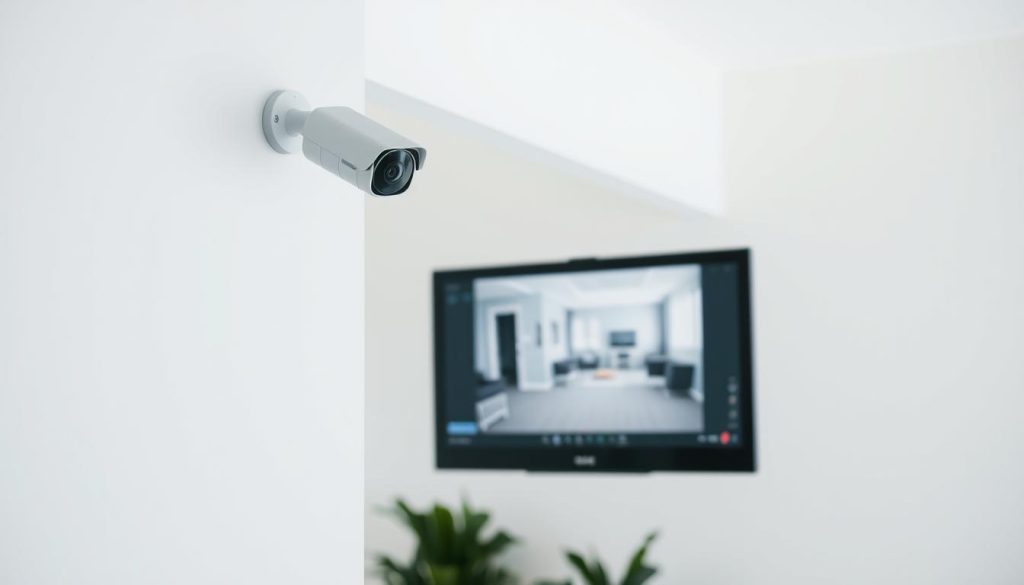
| Placement | Recording mode | Best use |
|---|---|---|
| Indoor | Event-based / pause with routines | Protect family areas, reduce false alerts |
| Wired outdoor | 24/7 option with Aware Plus | Continuous coverage at entry points |
| Battery outdoor | Event-priority recording | Flexible mounts with power-saving |
Value, pricing, and who should buy which Nest camera
Your choice should balance upfront cost with the days of searchable footage you plan to keep.
If you want the lowest cost of entry, the $99.99 wired camera is a solid pick. It works well in main rooms or hallways where steady power matters.
The $179.99 battery model fits if you need flexible placement or plan to mount units outside covered areas. You can wire it later to gain continuous timelines.
The $279.99 floodlight combines illumination with motion detection. Choose it when night deterrence and clear evidence matter most.
Subscriptions shape long‑term value. Nest Aware at $8/month gives 30 days of events, Familiar Faces, and sound alerts. Aware Plus at $12/month gives 60 days and up to ten days of 24/7 history for wired installs.
- The aware subscription covers unlimited cameras, so adding units won’t multiply plan costs.
- Factor in the optional weatherproof cable and likely discounts for multi‑packs when you budget.
- For rentals, pick the battery option to avoid drilling; homeowners gain the least fuss with wired power.
| Model | Price | Best fit |
|---|---|---|
| Wired | $99.99 | Low cost, steady power |
| Battery | $179.99 | Flexible mounts, can wire later |
| Floodlight | $279.99 | Night deterrence, bright video |
Conclusion
A simple, mixed setup often gives the best balance between coverage, cost, and easy use.
For a living room monitor, the $99.99 wired nest cam is the affordable, reliable choice. If you want one unit to move between rooms or tuck under an eave, the battery nest cam is the do‑everything pick.
Expect crisp 1080p video, HDR on the battery model, and a roughly 130°–135° field view. On-device recognition and AI detections speed alerts while encrypted cloud storage holds your clips; there is no local storage option.
For stronger night evidence, wire a unit or add a floodlight and opt for Aware Plus for extended video history. Two‑way audio, app controls, and familiar face tagging make daily checks fast so you actually use the system.
In most homes, one wired living room cam plus one under‑eave unit balances coverage, storage needs, and cost. Pick based on traffic, wiring comfort, and how often you review clips.
